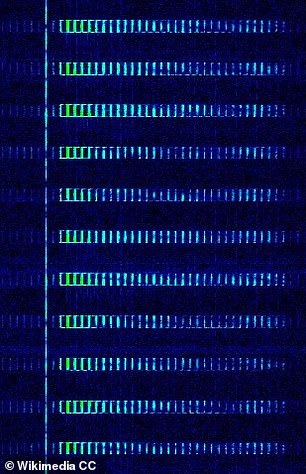For four decades, since the height of the Cold War, a mysterious radio signal has been broadcast from Russia, baffling amateur radio fans, scientists and spies alike.
Some speculate that it is part of the Russian government’s secret SETI program or even that it is actively communicating with a visiting alien species.
Others believe it could be an apocalyptic trigger for the ‘Dead Hand’, ready to launch nuclear weapons if Russia’s leadership is knocked out of commission.
But according to a professor of electronic and radio engineering who has studied the signal, one thing is certain: “It is almost certainly the Russian government that is using it.”
And: “If it is the Russian government, it would not be for peaceful purposes.”
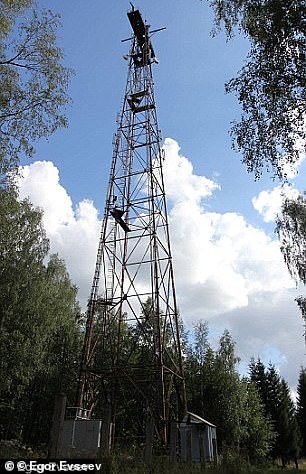
For four decades, since the height of the Cold War, a mysterious radio signal has been broadcast from Russia (example of signal at left), baffling amateur radio fans, scientists and spies alike. Above, on the right, one of the towers that transmit the signal, 30 kilometers from Moscow.
Teacher David Stupleswho teaches electronic and radio engineering at City University, London, personally believes that the enigmatic broadcast, nicknamed ‘The Buzzer’, was probably kept active as a safety mechanism in the event of nuclear war.
Transmitted on the shortwave radio frequency of 4625 kHz, Buzzer has led some physicists to speculate that its signal is being used to monitor Earth’s ionosphere.
But Professor Stupples, whose expertise is in reconnaissance platforms, surveillance and orbital or space navigation systems, acknowledges that there are still both incredible and mundane explanations on the table.
“They may simply be reserving the channel for air defense or some form of defense,” Stupples said. Popular Mechanics this week.
“If they don’t really use it, someone will steal it,” according to Stupples. ‘They’re keeping the channel available by broadcasting and saying, ‘this is ours.'”
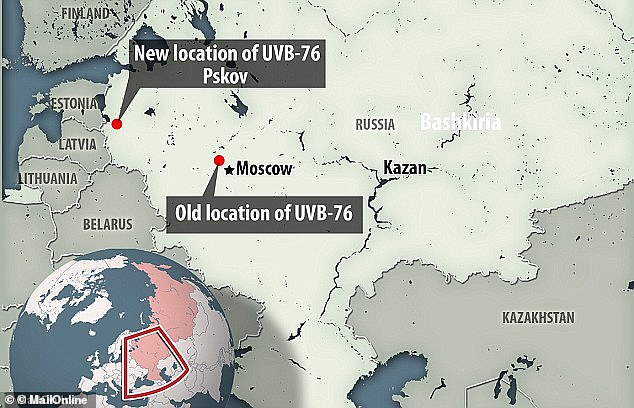
In 2010, the point of origin of the UVB-76 transmission changed, surrounded by strange events and new peculiarities of its seemingly random tones, voices, and information, which it has transmitted continuously since the 1970s.
Amateur radio interest and unclassified scientific interest in ‘The Buzzer’, officially known by its original call sign ‘UVB-76’, first increased in 1982.
Back then, the station was known to broadcast only a coded, disconcerting series of beeps, but in 1992 the transmissions became stranger: a series of buzzes, 25 times a minute, for less than a second each, and occasionally a sinister foghorn.
During the 1990s, the hum of UVB-76 would also be interrupted sporadically by anonymous male and female voices, reading lists of seemingly random names, words, or numbers.
The pitches of the noises the station broadcasts would also vary, potentially with secret information contained within those tonal changes.
This diversity of strange transmissions is what caught the attention of Professor Stupples and other researchers, because such variety is not typical of a simple “emergency placeholder” signal.
According to the surveillance engineering expert, a government or military institution that simply wants to maintain control of a given radio frequency will typically transmit a single basic test pattern, over and over again.
The UVB-76 ‘Buzzer’ not only transmits more complex and confusing signals, but it does so powerfully, with more than thousands of watts of energy transferred, according to Professor Stupples’ measurements, and in all directions.
“I’ve run it through my signal spectrum analyzers,” Stupples said, “and I can’t detect any intelligence.”
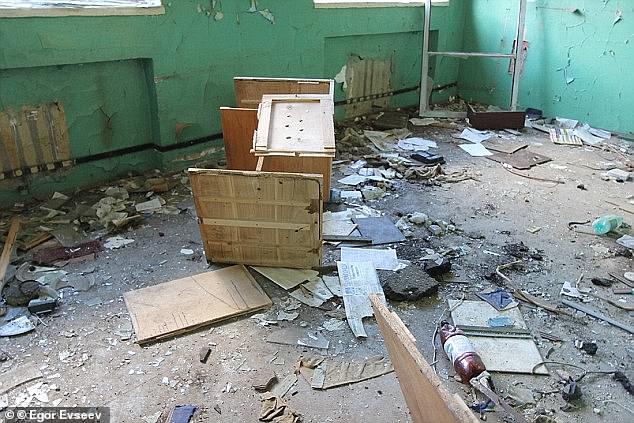
A Canadian-based Russian student, Egor Esveev, traced the mysterious transmission to an apparently abandoned Russian base near Pskov, on the border with Estonia. Esveev told MailOnline.com in 2014 that he found the abandoned place very disturbing.
FRelance radio monitor Ary Boender from the Netherlands, who runs the Numbers Oddities website, has heard and considered many theories about the signal over the years.
“Some say it’s an old Soviet dead man’s switch that triggers a nuclear attack on the West when it stops ringing,” he explained.
“Others say it’s a locator beacon for UFOs,” Boender continued, “or a mind control device with which the Russians can program your mind.”
“In the past it was said that it was a remote control station belonging to the Chernobyl nuclear power plant,” he recalls.
Jochen Schäfer, who for many years was head of a citizens’ group in Germany that spied on professional spies, once argued that Buzzer is a numbers station: a radio broadcast that allows agents in the field to transmit coded messages.
“It’s not a typical numbers station, but it is,” Schäfer insisted for cabling in 2011.
To this day, according to Stupples, all of these theories, even the most outlandish ones, could turn out to be true.
“It’s always entertaining, isn’t it?” Stupples told Popular Mechanics. “And you never know, one of those eccentric opinions might be right, and then we’ll all eat the humble pie.”
But the mystery of UVB-76 deepened in 2010, when it disappeared from its first site of transmission, which had been traced to a Russian army base near the town of Povarovo, 30 kilometers from Moscow.

Most of the buildings, some half-buried, were destroyed or abandoned according to Evseev, while in some areas cables had been visibly torn from the ground.
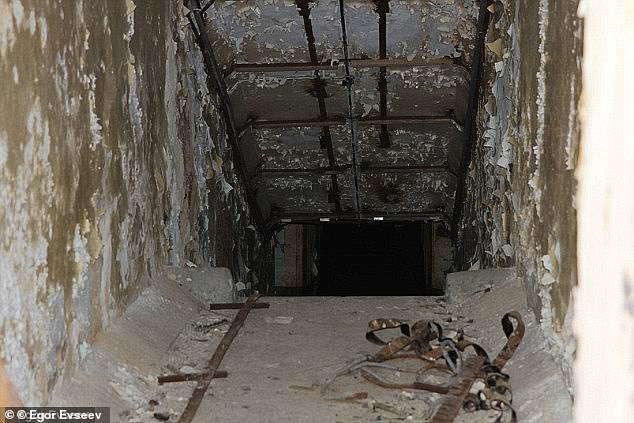
“We found tons of junk documents,” Evseev added. ‘One we found was quite interesting about the base’s cessation of operations’
The signal stopped transmitting for approximately 24 hours.
When it returned, strange pauses began to appear in the broadcast, and on August 25, 2010, amateur listeners eavesdropping on the station heard what they described as people shuffling around a room.
Some of these strange new transmissions resembled Morse code.
Then one day, the station began blaring excerpts from composer Tchaikovsky’s ballet ‘Swan Lake’, and the call sign changed from ‘UVB-76’ to ‘MDZhB’, spoken by a mysterious figure who It said ‘Mikhail Dumitri Zhengya Boris’.
The station also once broadcast a time signal, with a one-minute two-tune chime that sounded at the beginning of each hour. This was deactivated in June 2010 and no time signal has taken its place.
Interestingly, the codes have also been repeated for months or years, for unknown reasons. On January 26, 2011, the operator read “ILOTICIN 36 19 69 46.” This was repeated almost four months later, on May 11, 2011.
Russian student Egor Esveev, 20, originally from Moscow but now studying in Ottawa, told MailOnline in 2014 that he managed to trace the origin of the signal after it moved from Povarovo.
Esveev said that he found it near Pskov, on the border with Estonia, which he himself explored and photographed.
“Like any abandoned building or area, it was very creepy,” he told MailOnline in 2014.
“Strange people and very strange landscapes.”
Esveev said he encountered “a woman in her 40s” pushing “a baby stroller.”
“At first I thought it was a city resident who was out for a walk, but when she passed by I saw that her stroller was empty,” he said.
‘Who’s going to walk to an abandoned military base with an empty stroller?’
He said the station was configured as a “typical Russian military base” with two different perimeters.
Most of the buildings, some half-buried, were destroyed or abandoned, according to Evseev, while in some areas cables had been visibly torn from the ground.
“We found tons of junk documents,” he added. “One we found was quite interesting about the base’s cessation of operations.”
Esveev said he believes the station may be used for some form of internal communication that, “while secret, is not sensitive enough to worry about masking or keeping secret.”
But no matter how much people try to investigate the mystery of Russia’s 4625 kHz signal, according to UK-based electronics and radio engineering expert Professor Stupples, any definitive conclusion is likely to remain out of reach without some official confirmation.
“I think to find the whole truth, and nothing but the truth, it would have to come from the Russian Federation itself,” Stupples said.


